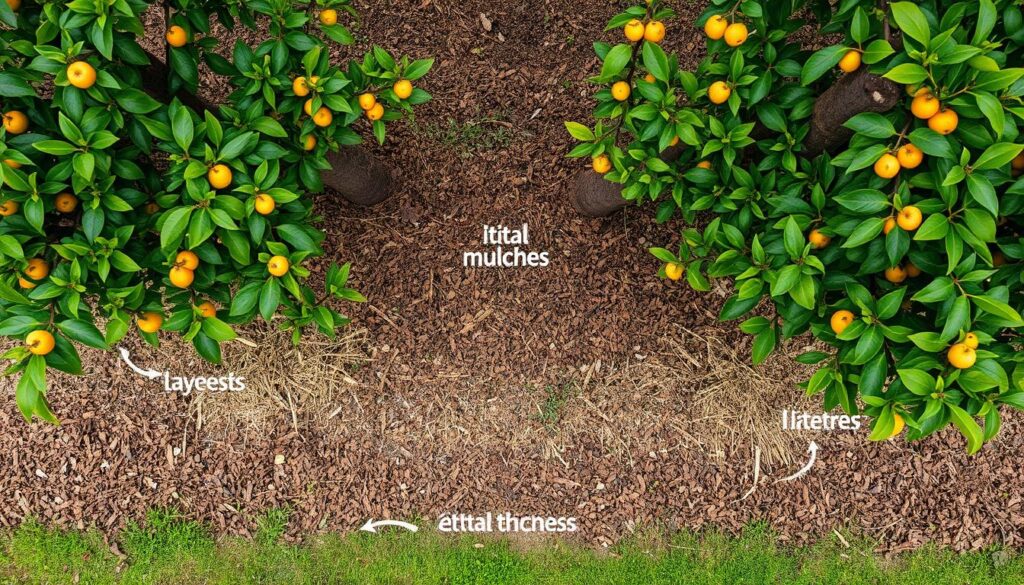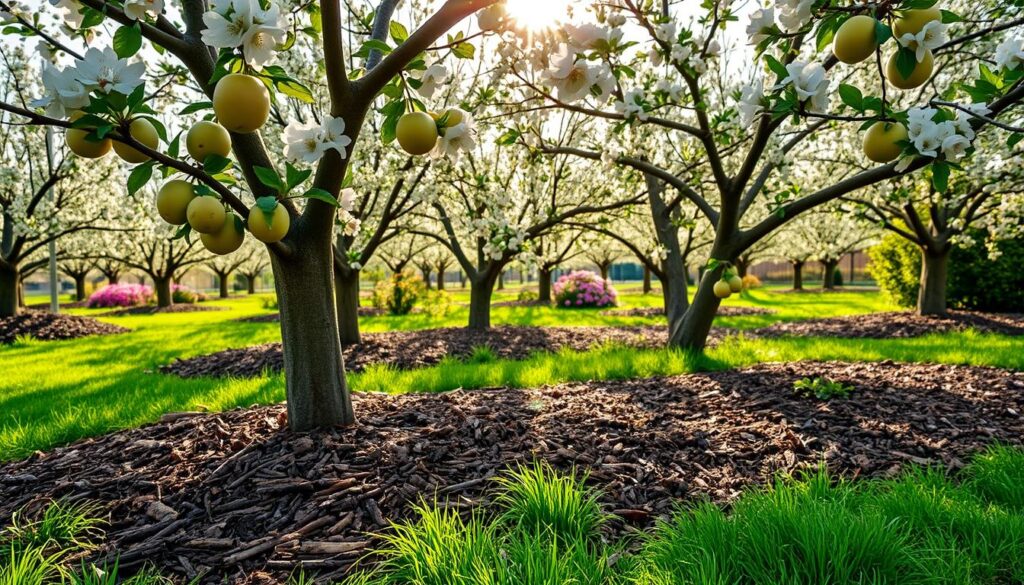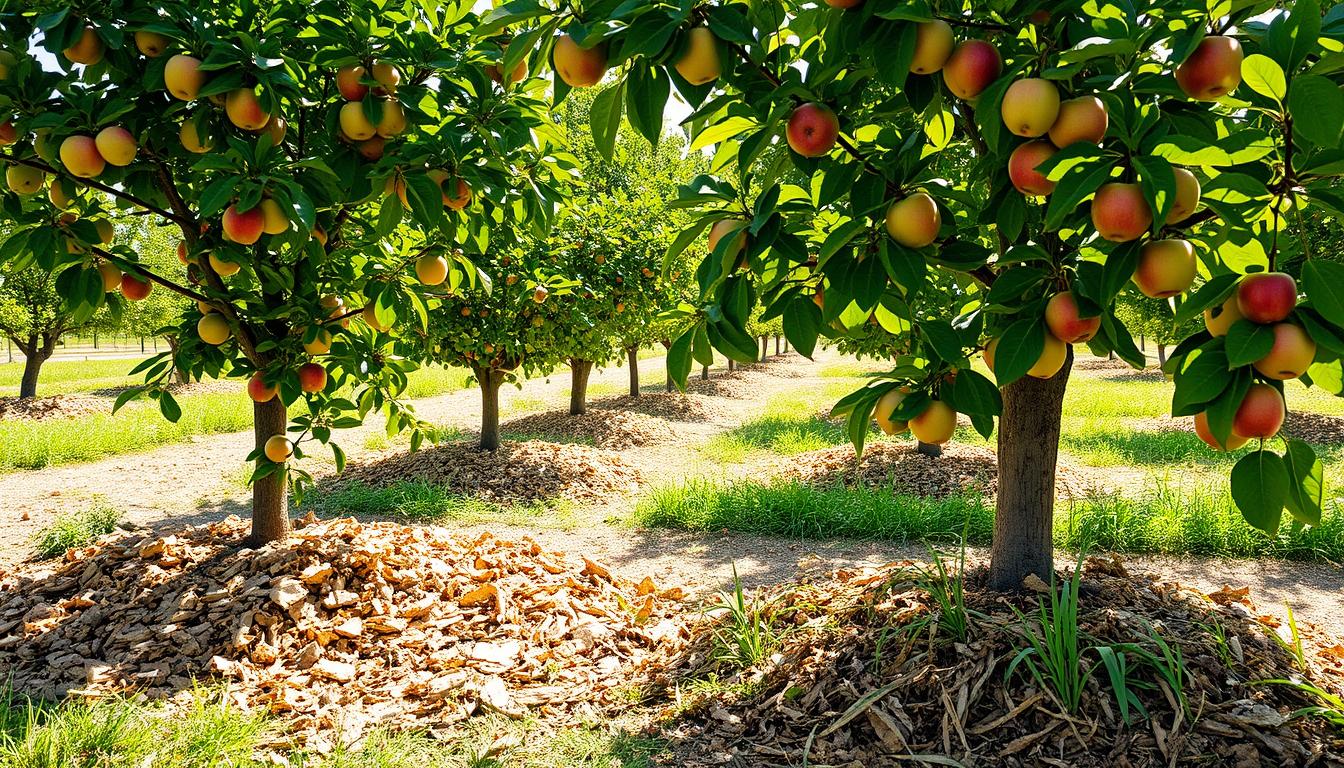As a gardener, I know how important it is to keep my fruit trees healthy and productive. The Best Mulching Techniques for Fruit Trees do more than just improve the soil. They also help with tree care in every climate. Mulching keeps the soil moist, controls temperature, and stops weeds, making a better home for my trees.
I’ve seen how mulch can make the soil better, leading to stronger growth and more fruit. For example, using mulch right can help trees bounce back quickly after bad weather. By keeping mulch 20-30 cm from the trunk, I avoid problems like collar rot. These tips make it easy to keep my fruit trees healthy and productive.
In this article, I’ll share the best ways and materials for mulching fruit trees, based on my own gardening experiences. I also suggest checking out Garden Beginner for more gardening tips and advice.
Key Takeaways
- Mulching is vital for the health of fruit trees in various climates.
- Proper mulching can help trees quickly recover from extreme weather.
- Keep mulch layers at least 20-30 cm from the tree trunk to prevent issues.
- Opt for organic materials for effective fertilization and moisture retention.
- Mulch thickness should ideally be between 5-20 cm for optimal results.
- Adding compost and fertilizers can boost tree vitality throughout the year.
Understanding the Importance of Mulching for Fruit Trees
Maintaining healthy fruit trees requires good gardening practices. Mulching is a key technique that enriches the soil and boosts tree growth. Knowing the benefits of mulching is crucial for any gardener aiming to improve their orchard.
Benefits of Mulching for Soil Health
Mulching improves soil structure and fertility. In cities, soil often gets compacted and lacks nutrients. Organic mulches like wood chips and straw help by adding nutrients and improving aeration.
They also help trees need less water. Mulch keeps the soil moist, reducing watering needs. This is good for both the gardener and the trees. For more info, check this resource.
How Mulching Affects Fruit Tree Growth
Mulching is key for fruit tree growth. It keeps soil temperatures stable, protecting roots from extreme weather. It also helps trees absorb nutrients better and resist drought and frost.
Mulching prevents diseases by controlling soil moisture. It keeps roots healthy by avoiding waterlogging. Using different mulches introduces nutrients and supports beneficial soil life. Healthy fungi, nurtured by decomposing mulch, boost tree growth.
Effective mulching creates a perfect environment for fruit trees. Choosing the right mulch improves soil structure, leading to a successful orchard. Embracing decomposition supports a healthy ecosystem for fruit trees.
Types of Mulch Suitable for Fruit Trees
Choosing the right mulch is key for fruit tree health and productivity. Both organic and inorganic mulches have their benefits. This lets me pick the best option for my garden or orchard. Knowing the differences helps me make the right choice for my fruit trees.
Organic Mulch Options
Organic mulches like wood chips, straw, and shredded bark boost soil fertility as they break down. Wood chips are especially good for fruit trees. They keep soil moist and protect roots from cold or heat.
They also stop weeds from growing, which means less competition for water and nutrients. Plus, fresh wood chips add nutrients that help trees grow strong and healthy.
- Wood Chips: Excellent moisture retention and insulation.
- Straw: Decomposes quickly and is lightweight.
- Pine Needles: Acidic nature benefits certain fruit trees.
- Shredded Bark: Slow decomposition ensures long-lasting coverage.
Inorganic Mulch Choices
Inorganic mulches like gravel, stones, and rubber mulch are also popular. They don’t improve soil like organic mulches do. But, they do keep weeds away and help keep moisture in the soil.
They need more upkeep because they don’t break down and add nutrients to the soil.
- Gravel: Lightweight and long-lasting.
- Stones: Great for aesthetics and weed suppression.
- Rubber Mulch: Durable and environmentally friendly.
The Best Mulching Techniques for Fruit Trees
Mulching is key for fruit trees to grow well. It improves soil quality and helps roots thrive. Knowing when and how much to mulch is important for the best results.
Timing Your Mulching Efforts
When you mulch matters a lot. I suggest doing it in late winter or early spring. This is when the soil starts to warm up, helping roots grow.
Mulch protects roots from temperature changes. It also keeps moisture in during dry times. This is especially helpful when it’s hot.
Ideal Thickness for Effective Mulching
Finding the right mulch thickness is important. A 2 to 4 inch layer is usually best. It lets air in and prevents moisture from harming roots.
If you’re using finely shredded mulch, 1 to 2 inches is better. It lets air through more easily. But, don’t make the layer too thick. It can cut off air and harm your trees.

Choosing the Right Mulch Material
Choosing the right mulch is key for fruit trees’ health. Each mulch type has its own benefits for soil, moisture, and nutrients. Knowing about these can really help your fruit trees grow better.
Compost and Its Benefits
Compost is a great addition to any garden. It adds important nutrients, boosting compost benefits for fruit trees. It also helps soil microbes thrive. Using compost as a base layer can make other mulches work better.
For best results, use well-rotted compost or manure. This speeds up decomposition and nutrient release.
Dried Leaves and Grass Clippings
Dried leaves make a great mulch, full of nutrients. They help soil health and support beneficial microbes. Dried grass clippings also work well, but make sure they’re dry to avoid matting.
These materials blend well with other mulches, making the mulch layer richer.
Wood Chips and Bark
Wood chips and bark are great for long-term mulching. They suppress weeds and keep moisture in. As they break down, they give nutrients back to the soil.
Apply wood chips up to the tree’s dripline, where feeder roots are. You’ll need to add more each year to keep the soil healthy. For tips on using wood chips, see this resource.
Applying Mulch: Step-by-Step Guide
Applying mulch is crucial for fruit tree care. It helps keep the soil moist and adds nutrients. This way, my trees stay healthy.
Preparing the Soil for Mulching
Before mulching, I prepare the soil. This means:
- Removing weeds and grass around the tree.
- Loosening the soil to help nutrients get in.
- Keeping the soil moist to help nutrients soak in after mulching.
Correct Mulching Techniques
Knowing how to mulch fruit trees is key. Here’s what I do:
- I spread the mulch evenly around the tree base.
- I keep it 8 to 12 inches from the trunk to avoid collar rot.
- The mulch layer is 2 to 4 inches thick to keep moisture in without harming roots.
- I make sure there’s a 1 to 2 inch gap between the mulch and the tree to avoid rot.
Using organic or inorganic mulch can improve soil quality. Regular mulching helps my fruit trees grow well, even in changing weather.
Seasonal Mulching Considerations
Knowing when to mulch fruit trees is key for their health and growth. Mulching in spring helps trees wake up from their sleep. It’s a great time to start.
Mulching Fruit Trees in Spring
In spring, it’s best to mulch with a 5 cm layer. This keeps the soil moist and weeds away. Make sure not to hurt the tree’s stems. Shredded leaves or compost are great choices for spring.
Adjusting Mulch for Weather Changes
Weather changes affect how much mulch we need. In hot, dry summers, add more mulch to protect roots. A 4-inch layer helps with extreme temperatures. But, in wet weather, reduce mulch to avoid disease. Keeping up with these changes is crucial for tree health.

| Season | Recommended Mulch Thickness | Mulch Type | Key Benefits |
|---|---|---|---|
| Spring | 5 cm | Organic (compost, shredded leaves) | Moisture retention, weed suppression |
| Summer | 4 inches | Organic (grass clippings, wood chips) | Temperature regulation, stress protection |
| Fall | 2-4 inches | Organic (leaf mold) | Nutrient addition, soil improvement |
| Winter | 2 inches | Inorganic (rocks, plastic sheeting) | Weed control, soil warming |
Common Mistakes to Avoid When Mulching
Many gardeners struggle with mulching, leading to mistakes that harm fruit trees. Knowing these common errors can greatly improve mulching’s benefits. Two big problems are overmulching and placing mulch incorrectly.
Overmulching and Its Effects
Too much mulch can hold too much water, harming the roots. This can cause roots to suffocate and increase disease risk. It’s best to use two to three inches of mulch for the right balance of water retention and weed control.
Regularly check and adjust the mulch depth to keep your trees healthy.
Improper Placement of Mulch
Where you place mulch is key. Never put it right up against the tree trunk to avoid moisture buildup. This can cause collar rot. Keeping the root flare exposed is essential for tree health.
Incorrect mulch placement can lead to more problems than it solves, reducing its benefits.
| Mistake | Consequence | Solution |
|---|---|---|
| Overmulching | Root suffocation, increased disease risk | Maintain 2-3 inches of mulch |
| Mulch too close to trunk | Collar rot, pest infestations | Keep mulch away from the trunk |
| Neglecting weed removal | Increased competition for nutrients | Weed before applying mulch |
| Using incorrect mulch type | Poor water penetration and soil health | Select appropriate mulch based on needs |
Additional Tips for Successful Fruit Tree Mulching
Successful fruit tree mulching needs focus on both tree nutrition and mulch health. Knowing how to feed trees while mulching and keeping mulch healthy is key. This way, your trees will flourish.
How to Feed Fruit Trees While Mulching
Adding fertilizer with mulch boosts tree nutrition. I sprinkle slow-release fertilizer before mulching. As it breaks down, it feeds the trees, supporting their growth.
Maintaining a Healthy Mulch Layer
Regularly check the mulch layer for successful mulching. It needs refreshing as it decomposes. Rake or turn the mulch to keep it healthy. This also prevents it from getting too thick and blocking air and water.
| Benefit | Detail |
|---|---|
| Nutrient Release | Mulch breaks down over time, providing essential nutrients to the soil. |
| Moisture Retention | Mulch helps retain soil moisture, reducing the need for frequent watering. |
| Weed Suppression | Applying a thick mulch layer effectively suppresses weed growth. |
| Soil Temperature Regulation | Insulation properties of mulch help maintain consistent soil temperatures. |
| Soil Health | Organic mulches support soil microorganisms, improving overall soil structure. |
Conclusion
Using the best mulching techniques for fruit trees is key for their health and yield. I’ve seen how organic materials make the soil better, help roots grow, and let water in. A good mulching plan boosts mulching’s benefits and keeps our gardens balanced.
It’s important to keep mulch away from the tree trunk to avoid too much moisture. A 4 cm layer is perfect for keeping water in and roots healthy. Studies show that mulching can increase yields a lot, like straw mulch did for peach trees.
Watching the seasons and changing my mulching as needed is crucial. This keeps my fruit trees healthy and helps them grow more. By doing this, I’m part of a group that knows mulching is great for plants and the environment.



Leave a Reply